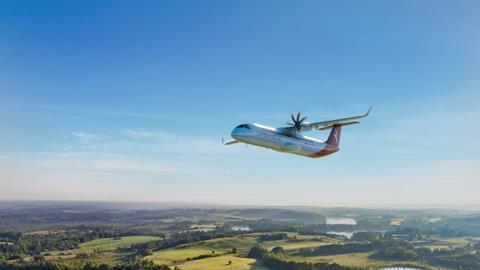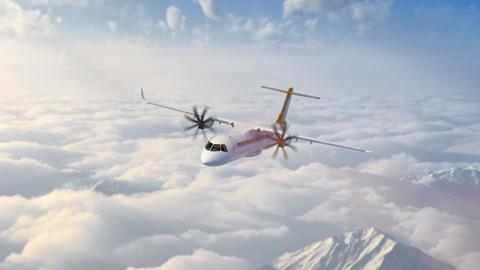Dutch start-up Maeve Aerospace has radically redrawn its aircraft development plans, dropping a previous proposal for a battery-powered 44-seater in favour of an 80-passenger hybrid-electric design.
Called the M80, the new aircraft is the latest major redesign by the fledgling company and is based on feedback from prospective customers, says chief executive and co-founder Jan Willem Heinen.

Launched in 2022 as the Echelon 01, the developer in June this year disclosed an update to aircraft, which was also rebranded as the Maeve 01.
Rather than the eight 1.2MW electric motors of the original configuration, the revamped design would now feature four 1.2MW motors, an elliptical fuselage, and a shorter wing. Maximum take-off weight (MTOW) was also cut to 25.9t, down from 45t initially.
But the latest change goes further still. While it retains the 2.85m (9ft 3in)-wide and 3.2m-high elliptical fuselage shape of its predecessor – and its 2-2 seating layout – the M80 is stretched by 7m to 27m overall.
To cope with higher speed flight, the shape of the wing changes and the span shrinks to 26m, from 29.7m previously, and the structure also gains a set of outward-canted winglets.
Gone are the four electric motors, to be replaced by a pair of hybrid-electric engines, each producing “a little bit more than 3,000shp” – or 2.2MW – says chief technical officer Martin Nuesseler.
He declines to reveal the identity of the propulsion provider but says it is “one of the three established [suppliers]”, in other words one of GE Aerospace, Pratt & Whitney Canada or Rolls-Royce.
“Our engine partner is recognised and has a new technology and sees our airframe as an opportunity to apply in a product this technology for the first time.”
The design changes cause performance to rise accordingly: range jumps to 800nm (1,480km), up from the Maeve 01’s figure of 250nm, while maximum cruise speed now sits at 400kt (740km/h) rather than the previous figure of 330kt. MTOW will be 28.9t, with a maximum payload of 8.5t.

“We were always looking to build the best regional aircraft possible,” says Heinen. “But the feedback from airlines was clear: we need double the capacity in passengers and three times the range.
“The worst thing to do as a young company is ignore the wishes of your customers.”
However, the changes also impact the service-entry target. Maeve had planned to fly the Maeve 01 in 2028 and obtain certification two years later. Although the maiden sortie target remains, the concept phase is extended by one year and now runs until mid-2026 and the completion of the preliminary design review stage; type approval and customer deliveries also slide to 2031.
“I am convinced that by doing a proper concept phase that this is the best way to have no delays later,” says Nuesseler.
Maeve claims the M80 will offer “regional jet performance with turboprop economics” and says the aircraft will offer 40% lower fuel burn than comparably sized regional jets.
Indeed, the manufacturer is targeting the replacement of Bombardier CRJ-series jets or the De Havilland Canada Dash 8 twin-turboprop with the M80 rather than the regional turboprop benchmark, the ATR 72-600.
Powered by twin 2,750shp PW127XT-M engines, the ATR 72-600 has a maximum cruise speed of 270kt and can fly up to 740nm with 72 passengers aboard.
“You can only replace jets if you get close to jet performance, otherwise people will ignore it,” adds Nuesseler.

However, the larger design now proposed may mean the composition of Maeve’s customer base also changes. To date, operators to have declared an interest in the Maeve 01 are Transavia-backed Dutch start-up airline Lucy and New Zealand’s Air Napier.
Although discussions continue with the two carriers, Nuesseler says the company is working to define “the top-level requirements” for the M80 with a group of four “recognised airlines” in the USA and Europe.
Heinen estimates it will require around $2 billion to bring the M80 to market but is hopeful that figure can be divided among revenue- and risk-sharing partners as the development progresses.
Maeve is aiming to raise $50 million through its current funding round, which is “well under way” and is expected to close in the first quarter of next year, he says; around half that figure has been pledged so far.
In addition to the change in aircraft configuration, Maeve is also spreading its wings beyond its home in Delft in the Netherlands and plans next year to open a new German engineering office in Oberpfaffenhofen near Munich.
Nuesseler – who was previously based on the same site during a stint as chief technical officer of Deutsche Aircraft – says the expansion is necessary to tap into the area’s pool of engineering talent.
“While there are a lot of young talents in the Netherlands, we also need people who have done two or three times already a new programme and these people we don’t get here,” he says.
In addition, he expects industrial partnerships, for example for airframe production, to be based “more in the centre of Europe”.
No decision has been taken on the location of the M80’s final assembly line, but Nuesseler anticipates this will be finalised over the next two years.


































